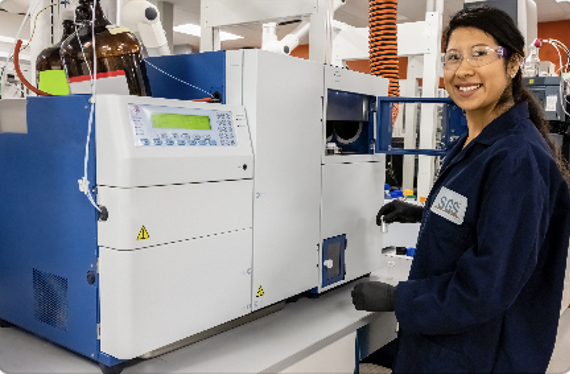
Routine Testing
Molecular weight is measured directly by GPC or indirectly by other techniques like solution viscosity or melt flow rate.
While Gel Permeation Chromatography/Size Exclusion Chromatography (GPC/SEC) is the method most commonly utilized for a direct measurement of a polymer’s molecular weight, we have a variety of analytical options which can probe differences in molecular weight. These variations can develop during processing or occur during changes in material lots.
The molecular weight is most easily described as the size of the molecules that comprise a polymer. Inherently, polymers have a distribution of sizes or chain lengths resulting in a molecular weight distribution. The properties of the polymer during processing as well as the properties of the final part are influenced by the polymer’s molecular weight and molecular weight distribution. For example, lower molecular weight polymers flow more easily to fill cavities during injection molding while a higher molecular weight version of the same polymer may offer improved mechanical properties which can be application critical. Additionally, the molecular weight of a polymer will change as the polymer is processed by molding or extrusion but potentially also during storage or use. This property is commonly monitored for lot release testing of medical devices such as stents but also packing materials like polyethylene terephthalate (PET) utilized in beverage containers
Approaches
The solubility of a polymer material is a critical parameter to be determined when choosing an analytical method for measuring molecular weight.
We regularly use the following analytical methods to either directly measure the molecular weight of a polymer or tracking general changes based on rheological properties:
- Gel Permeation Chromatography/Size Exclusion Chromatography (GPC/SEC)
- Common organic solvents like chloroform or tetrahydrofuran (THF)
- Buffered aqueous solutions
- High Temperature trichlorobenzene (TCB) for Olefins (polyethylene and polypropylene, PE and PP)
- High Temperature 1-Chloronapthalene for polyphenylene sulfide (PPS)
- Hexafluoroisopropanol (HFIP) for Polyesters and Nylons
- Inherent and Intrinsic Solution Viscosity (IV)
- Common organic solvents
- Concentrated acids like Sulfuric Acid for Nylons
- 60:40 Phenol/tetrachloroethane (TCE) for PET
- Hexafluoroisopropanol (HFIP)
- Melt Flow Rate (MFR)

The method that provides the most information regarding the molecular weight of a polymer is Gel Permeation Chromatography (GPC),also known as Size Exclusion Chromatography (SEC). GPC/SEC provides you with either a relative or absolute measurement of the molecular weight of the polymer as well as the molecular weight distribution. Depending on the type of calibration and detector used, we will provide you with relative molecular weight values compared to known standards and RI detection or absolute molecular weights based on the dn/dc value and MALS detection. GPC can also be used for determining the wt% composition of low molecular weight chains for regulatory purposes. This is accomplished by using a slice table methodology for the calculations and typically reported for composition below 500 g/mole and 1000 g/mole.
One of the most broadly useful techniques for comparing or specifying molecular weight limits is Dilute Solution Viscosity (IV). Inherent Viscosity and Intrinsic Viscosity can be used for specification QC purposes, such as lot release testing, but they will not provide the molecular weight distribution information that may be required in initial research investigations or in full qualification of a material. While GPC is commonly used to fully characterize materials during product development phases, it is common to concurrently analyze the same lots of material by the more cost efficient solution viscosity method so correlations can be made and solution viscosity values used for lot release testing during production. This is common for poly(lactic acid (PLA), polyethylene terephthalate (PET), and Nylons. Molecular weight is also monitored by Melt Flow Rate (R) which measures the mass of polymer that flows through a capillary of specified diameter during a set period of time. While this is not a direct measurement of molecular weight, a higher MFR value can indicate a shift to a lower molecular weight relative to other lots of the same material tested under the same conditions. This measurement is common to olefins like polypropylene and polyethylene and is commonly reported on technical data sheets and used for lot release testing for QC purposes
Sample Considerations
Sample submission will depend on the technique used and ranges from a minimum of about 20 mg of polymer (minus fillers) for GPC to about 100 g for MFR.
Contact and expert to determine the proper technique and associated sample considerations.
Experience
Products we’ve tested:
- Medical devices like stents
- Cellulose from recycled textiles
- Chitosan
- Fluoropolymers
- Polysaccharides
- Vicryl mesh
- Polypeptides
- Various resins such as polycarbonate, nylons, and PETs
- Nylon copolymers
- Ultrahigh molecular weight polyethylene for medical products
- Nitrocellulose used for ammunition and explosives applications
- Polyphenylene sulfide (PPS) GPC analysis
